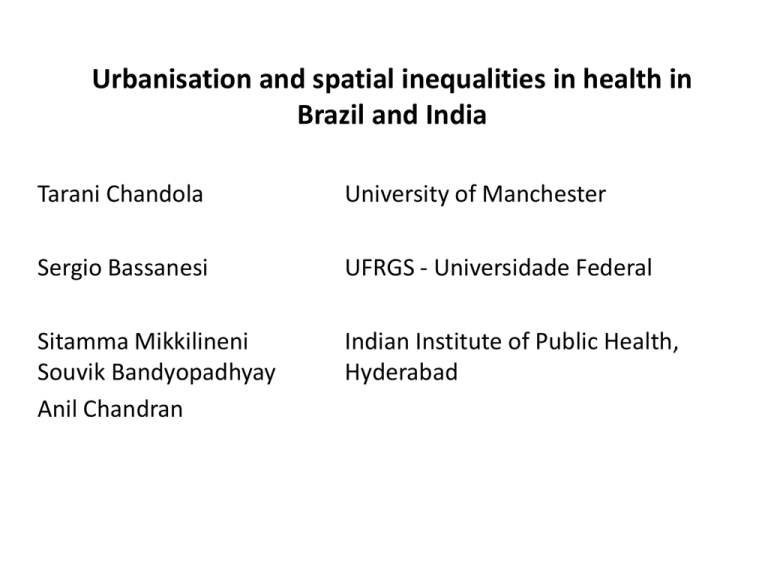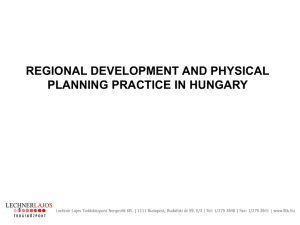
Urbanisation and spatial inequalities in health in
Brazil and India
Tarani Chandola
University of Manchester
Sergio Bassanesi
UFRGS - Universidade Federal
Sitamma Mikkilineni
Souvik Bandyopadhyay
Anil Chandran
Indian Institute of Public Health,
Hyderabad
Health is related to income differences within rich societies
but not to those between them
Between (rich) societies
Within societies
80
Life expectancy (years)
79
78
77
76
75
74
73
72
as
td
ep
riv
e
d
71
70
Le
Most
deprived
Electoral wards in England & Wales ranked by deprivation score
Source: Wilkinson & Pickett, The Spirit Level (2009)
www.equalitytrust.org.uk
Life expectancy and income inequality: Brazil, 2000
Plot showing the odds ratios (ORs) and 95% confidence interval (CI) for one-standard
deviation change in Gini coefficient for the risk of being underweight, pre-overweight,
overweight and obese.
Subramanian S V et al. J Epidemiol Community Health
2007;61:802-809
©2007 by BMJ Publishing Group Ltd
Increasing income inequality in Brazil and India
Increasing spatial inequality in poverty and income
- urbanisation and concentration of economic activity
- spatial concentration of affluence reproduces privileges of the rich
- spatial concentration of poverty results in segregation, involuntary clustering in
ghettos
Effects on Individual and Population Health?
“Triple health jeopardy: being poor in a poor neighbourhood that is spatially
isolated from life-enhancing opportunities…” Nancy A Ross
EVENNESS
ISOLATION
EXPOSURE
CLUSTERING
Dimensions of spatial segregation
Sean F. Reardon & David O'Sullivan. “Measures of Spatial Segregation”
p. 121-162, 2004
Sociological Methodology. V. 34, n.1,
EXPOSURE/ISOLATION DIMENSION
SPATIAL EXPOSURE INDEX
Average proportion of group n
in the localities of each
member of group m
SPATIAL ISOLATION INDEX
Average proportion of group m
in the local environments of
each member of group m
(spatial exposure of group m to
itself)
EVENNESS/ CLUSTERING DIMENSION
SPATIAL NEIGHBOURHOOD SORTING INDEX
Proportion of the variance between the
different localities that contributes to
the total variance of the variable X in
the city
GENERALIZED SPATIAL DISSIMILARITY INDEX
Average difference of the population
composition of the localities from the
population composition of the urban
area as a whole
Key hypotheses:
Districts, cities and states with less spatial socioeconomic inequalities have better
population health than areas with greater spatial socioeconomic inequalities
For a given level of income/socioeconomic position, people living in areas with less
spatial socioeconomic inequalities have better health than those living in more
segregated areas.
Methods:
Brazil Data (for the 25 largest cities):
Demographic and Socioeconomic data: 2000 Census (census tract level)
Mortality data: SIM Mortality Information System (district level data)
India Data:
Demographic and Socioeconomic data: 2001 census (sub-district Tehsil level)
Mortality data: District Level Household and Facilities Survey 2002-04 and 2007-08
(Individual and district level)
EVENNESS
EXPOSURE
ISOLATION
CLUSTERING
Dimensions of spatial segregation
Spatial CLUSTERING
Moran Scatter Plot
Spatially lagged variable
SLOPE OF THE REGRESSION LINE
Variable to be lagged, standardized
INDEX
Moran Cluster Map
Spatial CLUSTERING
Within each district, the
Spatial Clustering Index is
the proportion of census
tracts that are low income
tracts and are surrounded
by other low income tracts.
INDEX
EVENNESS
ISOLATION
EXPOSURE
CLUSTERING
Dimensions of spatial segregation
Spatial Isolation Index Income >20 ms
GLOBAL
Ŏ>20=0.228
p<0.01
BW:400m
LOCAL
Local
>20 ms
10-20 ms
2-5 ms
5-10 ms
Spatial Isolation Indexes
Income Groups
BW:400m
ms: minimum salaries
<2ms
INCOME
Moran I Index: 0.65 ( ρ< 0.0001)
Distribution of income of the head of the household by district, Porto Alegre, 2000.
Source: IBGE
AGE AND SEX
ADJUSTED
MORTALITY RATE
Moran I Index: 0.34 ( ρ< 0.0001)
Relative Index of Inequality: 1.8
Slope Index of Inequality: - 4.6
18
16
14
12
SALUD
10.0
10
8
6
5.4
4
2
0
0.0
0.2
0.4
0.6
RIDIT
0.8
1.0
Distribution of age and sex adjusted mortality rate by
district, Porto Alegre, 2000. Source: DATASUS-SIM
CARDIOVASCULAR
DISEASES MORTALITY
45-64 YEARS
CVD Deaths by 100,000
Moran I Index: 0.52 ( ρ< 0.0001)
Distribution of age specific cardiovascular diseases mortality
coefficient* , adjusted for age and sex, by district. Porto Alegre,
2000-2004. Sources: IBGE and SIM
* results after smoothing
Isolation indexes
Simple Linear Regression
Independent variables
Dependent variables
Standardized B coefficients and (R2)
Total
mortality
Premature
CV
mortality
External
causes
mortality
Pulmonary
tuberculosis
incidence
Without income
0.28* (0.08)
0.26 * (0.07)
0.35* (0.12)
0.45** (0.20)
With income to < 2 ms
0.36 * (0.13)
0.37* (0.11)
0.42 ** (0.17)
0.52** (0.27)
2 to < 5 ms
0.19 (0.04)
0.18 (0.03)
0.22 (0.05)
0.30* (0.09)
5 to < 10 ms
- 0.16 (0.03)
- 0.19 (0.04)
- 0.21 (0.04)
- 0.13 (0.02)
10 to < 20 ms
- 0.41** (0.17)
- 0.44** (0.19)
- 0.46** (0.21)
- 0.37* (0.13)
20 or more ms
- 0.53** (0.28)
- 0.52** (0.27)
- 0.53** (0.28)
- 0.47** (0.22)
Income groups
Isolation
indexes
* Significant p<0.05
** Significant p<0.001
ms: minimum salaries/month
Band Width: 400 m
Exposure indexes
Simple Linear Regression
Dependent variables
Standardized B coefficients and (R2)
Independent variables
Income groups
Exposure indexes
Total
mortality
Premature
CV
mortality
External
causes
mortality
Pulmonary
tuberculosis
incidence
>0 to <2 ms
No income
0.31* (0.09)
0.29* (0.08)
0.38* (0.15)
0.49** (0.24)
2 to <5 ms
< 2 ms
0.28* (0.08)
0.26* (0.07)
0.33* (0.11)
0.43** (0.19)
10 to <20 ms
≥ 20 ms
- 0.52** (0.27)
- 0.53** (0.28)
- 0.54** (0.29)
- 0.46** (0.21)
5 to <10 ms
≥ 10 ms
- 0.41** (0.17)
-0.44** (0.19)
- 0.45** (0.21)
- 0.36* (0.13)
* Significant p≤0.05
** Significant p ≤ 0.001
Band Width: 400 m
Average proportion of group n in the
localities of each member of group m
Spearman Correlation Coefficient
2 to <5 ms
< 2 ms
-0.488**
Tuberculosis
Tuberculosis
Spatial Exposure Index
>0 to <2 ms
No income
-0.634**
Tuberculosis
0.679**
Tuberculosis
0.698**
10 to <20 MS
≥ 20 ms
5 to <10 ms
≥ 10 ms
CLUSTERING INDEX
Simple Linear Regression
Independent
variable
Spatial
CLUSTERING
INDEX
Standardized B
R2
Dependent variables
Total mortality
Premature CV
mortality
External causes
mortality
Pulmonary
tuberculosis
incidence
0.65**
0.63**
0.64**
0.68**
0.42
0.39
0.41
0.46
Scattergram
Clustering Index
** Significant p ≤ 0.01
Clustering Index
Clustering Index
Clustering Index
Linear Regression
Dependent variables
Standardized B coefficients and R2
Independent variables
Mean Income
Clustering Index
R2
Mean Income
Isolation Index
10 or more ms
R2
Mean Income
Exposition Index
5 to <10 ms
R2
* Significant p<0.05
** Significant p<0.01
≥ 10 ms
Total
mortality
Premature
CV
mortality
External
causes
mortality
Pulmonary
tuberculosis
incidence
- 0.40**
- 0.30*
- 0.31*
- 0.33*
0.33*
0.39*
0.41**
0.42**
47.7
42.6
45.0
49,8
- 0.54**
- 0.46**
- 0.47**
- 0.59**
- 0.21
- 0.26*
- 0.27*
- 0.12
46.5
41.5
43.8
44.1
- 0.59**
- 0.52**
- 0.53**
- 0.60**
- 0.22*
- 0.27*
- 0.28**
- 0.17
48.0
43.3
46.0
45,6
ms: minimum salaries/month
Next steps:
Brazil: Obtain and analyse data for other Brazilian cities
India: Analyse DLHS-3 data in a multilevel and spatial context
Workshops on Spatial and Multilevel Analysis:
Brazil: May 18-20 2010
India: June 2-4 2010







